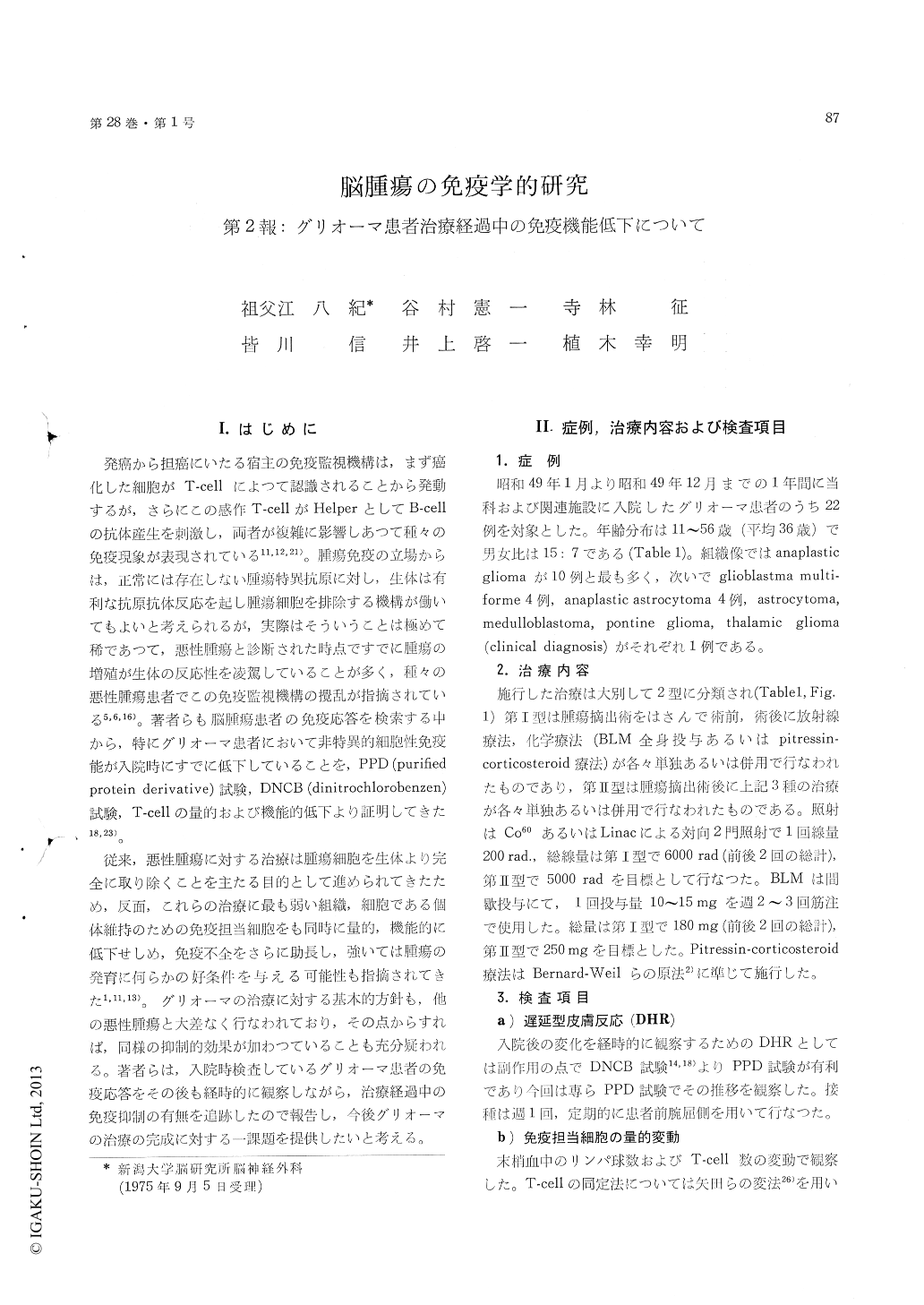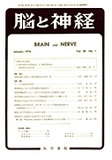Japanese
English
- 有料閲覧
- Abstract 文献概要
- 1ページ目 Look Inside
I.はじめに
発癌から担癌にいたる宿主の免疫監視機構は,まず癌化した細胞がT-cellによつて認識されることから発動するが,さらにこの感作T-cellがHelperとしてB-cellの抗体産生を刺激し,両者が複雑に影響しあつて種々の免疫現象が表現されている11,12,21)。腫瘍免疫の立場からは,正常には存在しない腫瘍特異抗原に対し,生体は有利な抗原抗体反応を起し腫瘍細胞を排除する機構が働いてもよいと考えられるが,実際はそういうことは極めて稀であつて,悪性腫瘍と診断された時点ですでに腫瘍の増殖が生体の反応性を凌駕していることが多く,種々の悪性腫瘍患者でこの免疫監視機構の攪乱が指摘されている5,6,16)。著者らも脳腫瘍患者の免疫応答を検索する中から,特にグリオーマ患者において非特異的細胞性免疫能が入院時にすでに低下していることを,PPD (purifiedprotein derivative)試験,DNCB (dinitrochlorobenzen)試験,T-cellの量的および機能的低下より証明してきた18,23)。
従来,悪性腫瘍に対する治療は腫瘍細胞を生体より完全に取り除くことを主たる目的として進められてきたため,反面,これらの治療に最も弱い組織,細胞である個体維持のための免疫担当細胞をも同時に量的,機能的に低下せしめ,免疫不全をさらに助長し,強いては腫瘍の発育に何らかの好条件を与える可能性も指摘されてきた1,11,13)。グリオーマの治療に対する基本的方針も,他の悪性腫瘍と大兼なく行なわれており,その点からすれば,同様の抑制的効果が加わつていることも充分疑われる。著者らは,入院時検査しているグリオーマ患者の免疫応答をその後も経時的に観察しながら,治療経過中の免疫抑制の有無を追跡したので報告し,今後グリオーマの治療の完成に対する一課題を提供したいと考える。
A large amount of research has been carried outon the immune system of patients with malignantneoplasm. We have already pointed out, in theprevious reports of this series, the details of thesuppressed cell-mediated immunity in patients withbrain tumor, particularly in those with glioma.And it was concluded that the suppressed cell-mediated immunity in them was closely related toboth the dysfunction of each T-cell and the decreaseof T-cell counts in general. Although it couldnot be made clear whether the suppressed cell-mediated immunity occurred prior to or subsequentlyto the development of brain tumor, patients maywell have been affected by the suppression as aresult. In relation to this problem, it seems im-portant to observe the changes of immunologicalresponses during treatments and to discuss thecorrelation between the immunological responsesand treatments.
Twenty-two patients with various gliomas (ana-plastic glioma, 14; glioblastoma multiforme, 4;astrocytoma, 1; medulloblastoma, 1; pontine glioma,1 and thalamic glioma, 1) admitted from January,1974 through December, 1974 provide the substanceof this study. Thirteen cases were treated withX-ray irradiation before and after the surgicaloperation combined with simultaneous prescriptionof Bleomycin and/or pitressin-corticosteroid therapy(group-I). The other nine cases were treated withX-ray irradiation combined with them only afterthe surgical operation (group-II). Immunologicalresponses were investigated weekly during thetreatment by means of the indicators as mentionedbelow.
With the advance of the treatment, skin reactivityto PPD was suppressed in six cases of group-I andtwo of group-II. Three of the six cases of group-I showed transient recovery in the intermittingperiod of the treatment. In six cases of each group,skin reactivity remained unchanged. Of these, onecase of group-I and two cases of group-II showedtransient suppression in the periods of the treat-ment.
Lymphocyte and T-cell counts of group-I weredecreased during the periods of the treatment andwere recovered transiently during the intermittingperiod of the treatment. But when looked at onthe whole, these counts tended to be decreasedgradually and there were statistic differences be-tween before and after the treatment. As withgroup-I, lymphocyte and T-cell counts of group-IIwere decreased during the treatment, but wererecovered at the early stage after the treatment.There were no statistic differences between beforeand after the treatment. In each group, thechanges of lymphocyte and T-cell counts weresimilar, showing W-shaped fluctuations in group-Iand V-shaped fluctuations in group-II. Lymphocyteand T-cell counts tended to be de creased in cor-relation with the suppression of PPD reaction.
Blastic transformed response of lymphocytes toPHA was also suppressed, concurrently with theperiods of the treatment and was recovered duringthe intermitting period of the treatment in someof each group.
Serum levels of immunoglobulins (Ig-G, Ig-A,Ig-M) were measured weekly during the treatment.There were no definite relations between them ineach group. And it was uncertain whether thetall of them were concerned with the decrease andthe dysfunction of T-cells which were the helperto produce immunoglobulins.
From the results mentioned above, one may con-clude that the immunological responses betweenthe two groups as to contents of the treatment.Accordingly it is surmised that the prolonged treat-ment may play an important role of immuno-sup-pression. Although it is to be studied in futurewhether the immuno-suppression in each group,particularly in group-I, is reversible or not, pa-tients may be affected by the immuno-suppressionwhich is in no way avoidable in the course of thetreatment. To accomplish treatments for patientswith glioma, further studies of a long-term periodare needed through all over the clinical courses andsome of the immunological treatments must beintroduced to meet the demand of the case.

Copyright © 1976, Igaku-Shoin Ltd. All rights reserved.


